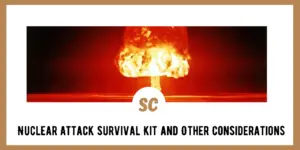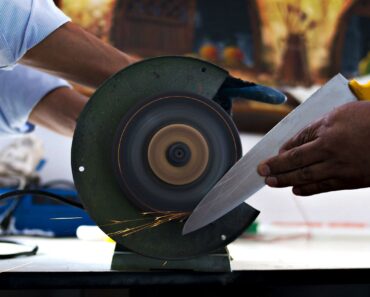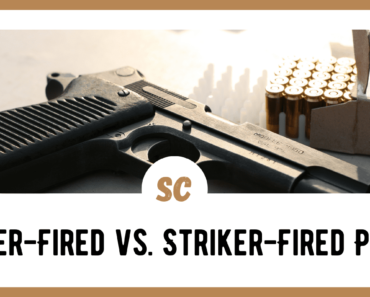Ever since World War 2, people have had to worry about a threat that they didn’t have to before the war. That threat of course, is nuclear warfare.

Once we learned how to “harness the power of the atom,” we created a bomb that was so devastating that it only took two to end the war.
When the war ended, the race was on to create bigger and better nuclear bombs and to stockpile as many as possible. At it’s peak, The United States was estimated to have upwards of 70,000 nuclear warheads, while The Soviet Union (now Russia) at around 45,000 warheads.
Today, the stockpiles of both sides have supposedly been reduced to a few thousand, but that’s still more than a couple needed to cause global damage. Of course, there are other nations that have developed or acquired nuclear weapons and some of those nations, like North Korea, are very vocal of their desires to use them.
With the potential for nuclear attacks so high, it begs the question…
Can You Survive a Nuclear Attack?
The answer to this question is yes you can survive a nuclear bomb, but you are not going to survive if you take the old “duck and cover” advice to heart.
To better your chances of survival, we must digger deeper into this topic to understand how one can survive such a devastating event.
Types of Nuclear Bombs
Tactical
Nuclear Weapons called “tactical nukes” are bombs or missiles that carry a warhead with a relatively small yield. They are meant to be used on the battlefield to overwhelm an opposing enemy while minimizing collateral damage.
Strategic
Nuclear Weapons called “strategic nukes” are bombs or missiles that usually have a much higher yield, and therefore are designed for maximum damage.
Nuclear Weapons by Size
Since World War 2, there has been advancements in nuclear weapons that include range, accuracy, and yield.
To give you a reference point, the bomb dropped on Hiroshima, Little Boy, had a 15 kiloton yield. The one dropped on Nagasaki, Big Boy, had a 22 kiloton yield.
Today, the largest bomb that The United States has tested is the Castle Bravo. It has a yield of 15 Megatons (1,000 times larger than Little Boy), and the largest one Russia has tested is the Tsar bomb, with a yield of 50 Megatons (3,333 times larger than Little Boy).
Effects of Nuclear Bombs
When we think of a bomb, we tend to only think of the blast effects, In most conventional bombs, that area is relatively small. But with a nuclear blast, that area is much bigger.
Additionally, even if you are outside of the immediate nuclear blast zone, there are other factors that must be taken into account:
- Radiation Radius
- Fireball Radius
- Heavy Blast Damage Zone
- Moderate Blast Damage Zone
- Light Blast Damage Zone
- Thermal Radiation Radius
It goes without saying that the effects of an explosion are more powerful and dangerous the closer you are to the point of impact. However, the effects of nuclear blasts listed above can be far reaching.
For example, one of the largest nuclear bombs ever tested was carried out by Russia when they tested the Tsar bomb. It was reported that the shockwave damaged windows in a village some 400 miles from the explosion.
Probably the most concerning effect for someone who isn’t even in the region of a detonation, is radioactive fallout exposure risk. Depending on prevailing winds, radioactive material can travel hundreds of miles or more.
Types of Nuclear Attacks
There are different types of systems and delivery methods out there, but here are four different types of nuclear attacks that would most likely be used and therefore should be on your radar.
1. Limited Strike
This scenario entails only one – or perhaps several – nuclear warheads being detonated. The localized effects of a limited strike/counterstrike would be devastating. However, the world at large would survive.
Outside of the blast zone, the biggest threat to nearby populations would be radioactive fallout exposure risk.
This type of strike could be used by rouge individuals or nations or as a means to “escalate to deescalate.” Escalate to deescalate was a method used by the United States in World War 2. By using the largest bomb ever created, the U.S. brought the largescale war, that had been raging for years, to a close.
2. Dirty Bomb
Dirty bombs generally are not nuclear warheads (although they can be), but they are worth mentioning because they are paired with chemical, biological, or radioactive materials.
The main purpose of a dirty bomb isn’t so much the destructive force of the explosion. Rather, the explosion is a delivery system for the secondary payload, which in the case of this article, would be radioactive material.
3. High Altitude Nuclear Explosion (HANE)
The three main ways a nuclear bomb will be detonated will be as an air burst, on the surface, or at high altitude.
A ground detonation explodes at ground level, but the effectiveness of the bomb is less since the ground absorbs a lot of the energy.
Keep in mind that the two bombs used in World War 2 were ground detonations, which still had devastating results. A ground detonation produces the iconic mushroom cloud.
An airburst is when the bomb explodes above ground level, anywhere from a couple of hundred feet and above. An airburst causes a much more destructive shockwave, and it usually doesn’t create a mushroom cloud.
A high altitude nuclear explosion is detonated around 20 miles and higher above the ground. One of the main threats from a HANE is the byproduct of a nuclear blast, an electromagnetic pulse (EMP).
An EMP is a pulse of highly charged particles that we cannot see with the naked eye – nor is it harmful to the human body. What it does harm is the electrical grid and electronic devices by basically “frying” the circuitry.
The technology that now runs our daily lives has become smaller, faster, and more delicate, which means we have to worry about an EMP.
A high-altitude nuclear explosion won’t create the recognizable mushroom cloud and depending on the elevation at which it is detonated, we won’t have to worry too much about a blast wave. We will have to worry about the EMP.
Arguably, an EMP is more devastating than a ground explosion or a low level air burst. This is because everything electronic that is within the range of the EMP may not turn back on. We may not know the full extent of EMP damage, but it is estimated that 50% of the population in the affected area could die within the first month.
4. Mutually Assured Destruction (MAD)
MAD stands for Mutually Assured Destruction ,and this doctrine applies to countries that have stockpiles of nuclear bombs and missiles – such as The United States and Russia.
Let’s use the two countries from above as an example. According to MAD, it is unlikely for one of these countries to launch only one nuclear device against the other because the targeted country has a lot of nuclear devices as well. So, the situation would quickly escalate to the point that both countries are launching hundreds if not thousands of nukes at one another, hence MAD.
You should know that MAD isn’t a situation that would buildup over time. Once it is confirmed that one country has launched against the other, there will be a lot of nuclear warheads in the sky within a very short time.
This type of attack could result in what is called “nuclear winter.” Basically, so much debris is thrown into the atmosphere that it would block out the Sun. Maybe not in its entirety, but enough that it would affect life on the planet.
How long a nuclear winter would last depends on several variables, but some estimates say it could last anywhere from 1-10 years.
Nuclear Bomb Scale
It can be a difficult thing to imagine the scale of a nuclear explosion. If you really want to be prepared for a nuclear disaster, then you need to be able to identify the most likely targets around you and how far the aftermath will reach.
There are several online simulators that you can use that will give you a better idea of the scale of a nuclear blast, such as NUKEMAP by Alex Wellerstein (nuclearsecrecy.com).
The simulator allows you to choose different variables, like:
- The location of the explosion
- The size of the warhead
- Whether it’s an airburst or surface detonation
After the parameters are selected, you then click the red “detonate” button.
The map will then show you the radius of the fireball, radiation, thermal radiation, moderate and heavy blast damage. The simulator also estimates the number of causalities, as well as showing the distance of radioactive fallout exposure risk.
One of the best solutions for dealing with any threat is to not be where the threat is. But since the affects of a nuclear blast can be so far reaching, that can be difficult. This is why the simulator is so helpful.
You can look at the region you live in and decide which areas are the most likely targets. Generally speaking, the most likely targets of a nuclear bomb will be military installations, high density population centers (big cities) and areas of logistical support (manufacturing, food, water, and fuel supplies).
Once you have identified these areas, you can plug them into the simulator and see how the results will affect you.
Can You Survive a Nuclear Attack? (part 2)
Given the information discussed so far, we can begin to better answer this question with a little more clarity.
Let’s go through four scenarios using the four different types of attacks discussed earlier in the article.
1. Limited Attack (One Strike)
Chances of survival at ground zero without being in a hardened underground structure are almost zero.
Chances of survival within the heavy blast zone without being in an underground structure are almost zero as well.
Chances of survival within the moderate blast damage radius are higher, especially if you are underground.
Chances of survival outside of the light blast damage radius are high, but radiation exposure is also still high.
Overall, the best protection factor is to be underground.
2. Dirty Bomb
Considering that the blast from these is relatively small – at least when comparing them to a nuclear explosion – chances of survival are very high if you are not within the blast radius or the radius of the radioactive fallout.
Keep in mind that the main purpose of a dirty bomb is the delivery of a chemical, biological, or radioactive material.
3. High Altitude Nuclear Explosion (HANE)
Unless you happen to be in an airplane – possibly even in space – you most likely won’t have to worry about the blast, or thermal radiation (heat) from a high-altitude nuclear explosion.
However, the EMP from this type of attack will instantaneously affect the electrical grid and electronics. So, your survival will entirely depend on how prepared you are to live without power or anything that uses a computer, your food and water supply, your health, and your level of self-sufficiency.
To give you a better understanding of this scenario, it is estimated that it would only take 3-4 high altitude nuclear explosions to wipe out the power grid and logistical support of a nation the size of the United States. Recovery from such an event, if it happens at all, would take decades.
4. MAD
The chances of survival within or near strike zones is limited, especially if you consider that targeted areas won’t have to worry about just one nuclear bomb, but several. It is likely that several nuclear bombs will be spread out over a targeted area to ensure maximum effectiveness.
Due to the widespread radioactive fallout and debris put into the atmosphere, the only way to ensure your survival in a nuclear holocaust event, is to be prepared to live underground in a fallout shelter for a long time.
Protection Factor
Scenarios involving a nuclear bomb(s) seem pretty grim, and they are. But given the circumstances, they are survivable. However, without protection from the initial blast and radioactive fallout, an emergency kit isn’t going to be much help.
The best way to protect yourself against the effects of a nuclear explosion is to get underground or to find a fallout shelter.
There are hardened underground structures that are capable of withstanding a direct nuclear strike, but most of these are designed for the military and the government.
Some countries have invested in underground shelters for the general public, but most have not.
For most people, the best options are to invest in a fallout shelter, bunker, use a basement, or retreat to a natural shelter such as a cave or underground tunnel system.
Nuclear Survival Kit
A nuclear survival kit isn’t going to be your normal kit that can fit into a bag or small container.
For the supplies listed below, the goal should be to have enough resources to last at least one year.
1. Dosimeter and Geiger Counter
These two items will be important in the kit as they measure radiation levels. Geiger Counters are handheld devices, whereas personal dosimeters are cards or badges that can be carried or worn. Typically, these cards have a color indicator that changes depending on radioactive fallout exposure.
2. Canned Food
Food supply contamination is something you need to consider in effected areas. Additionally, the food chain will also be disrupted due to overwhelming, crushing demand.
Open containers of food should not be consumed, and outdoor food sources are likely to become contaminated by nuclear fallout.
Canned food may not be the healthiest choice, but it’s affordable, has a long shelf life, and doesn’t need to be cooked before consumption. Having a healthy supply and variety of canned food in your fallout shelter will be beneficial.
Include extra can openers and mess kits.
3. Water
Water is critical to life, but unfortunately water sources are another area that can become contaminated from nuclear fallout. There are a few filtration processes which can decontaminate water with radioactive components, but whether or not these will suit your situation or capabilities is for you to decided.
This is why storing enough water will be difficult, but essential.
The absolute minimum that should be stored is one gallon per person per day. Realize that this is just for drinking purposes and not cleaning, cooking, or sanitation.
4. Personal Hygiene Items
Maintaining proper hygiene helps to prevent health issues, as well as boost morale. Personalize this category to suit your needs, but the basics should include soap and oral care (toothbrush).
5. Personal Sanitation Plan/Materials
Being stuck in a rather small space for a long time poses sanitation risks, which is why a plan for human wastes is critical.
What plan you choose will obviously depend on where you are sheltering and its capabilities. Some shelters/bunkers have plumbing built into them, but other choices include composting toilets.
6. First Aid Kit
Medical services are most likely not going to be available, at least not in the short term.
Stockpile OTC (over the counter) medications, prescription medications, and any other essential medications, materials for dealing with burns, and trauma supplies.
Potassium iodide (anti-radiation drug) tablets should also be included in your first aid kit. Potassium iodide is not a cure-all for radiation exposure, but it does help to block pathways in the body that would otherwise absorb radioactive iodine in the thyroid gland. This can help with radiation sickness.
Since you are going to have to be your own doctor, it will be necessary to have medical books on hand for emergency reference material. Be sure they are physical copies and not stored on a device.
7. Pet Food
It can be easy to sometimes forget to plan for our pets, but if they will be sheltering with you then you will need to plan on an emergency kit for them that includes a food supply, water, and anything else they will need.
8. Power Source
With possible EMPs and the electrical grid being destroyed by nuclear blasts, power outages will be a certainty in nuclear war. If it doesn’t come to all-out nuclear war, then large solar panels can be set up to feed power to your home or shelter. These will help to combat power outages.
9. Lighting
An emergency preparedness kit should always have multiple sources of light that includes lanterns, hanging lanterns, headlamps, and flashlights. Be sure that your power-generating resources will keep your lights running.
10. Air Filtration System
Whether you are above ground or below ground, you will need a system in place that can filter contaminated air.
11. Communications
For direct communications between two parties, you will need something like a HAM radio, because it is likely that cell towers will not be operational. However, in most areas, you will require a license or permit to become a HAM operator.
A basic plan for obtaining information should also include an emergency radio like an NOAA weather radio.
12. Duct Tape
Duct tape is a fantastic product to have on hand due to its versatility. For this specific emergency kit, it will be helpful for sealing up breaches where nuclear fallout could get through.
13. Plastic Sheeting
Plastic sheeting also has a lot of uses, but for the nuclear survival kit, it helps in sealing areas off from nuclear fallout. Use this along with duct tape for a better seal.
14. Local Maps
It is likely that electronics won’t work or the services that the device uses won’t be running. Everyone is so used to using GPS in modern times, but you shouldn’t plan on that being available to you.
A healthy stack of physical maps will help you to get where you are going, should you have to travel, to find resources, and to better gauge the level of certain threats.
15. Fire Extinguisher
A nuclear survival kit should include fire extinguishers and as many fire extinguishing methods as possible. Even after a nuclear bomb has happened, there will be an increased risk of widespread fires.
16. Documents/Valuables
In the process of rebuilding, or should you have to travel, the following documents may be necessary:
- Important Family Documents
- Social Security cards
- Birth certificates
- ID
- Medical history
- Bank account records
- Any other documentation that you feel is critical to have
Keep these documents protecting in an airtight, waterproof, hard container.
17. Clean Room
If you have the space and means to set up a clean room, it would be a good idea. This is an area that is designed for contaminated clothes to be removed and for a person to shower and scrub down before entering the main living quarters.
This process will be made easier if a stack of disposable clothing/hazard suits are a part of your nuclear survival emergency kit.
Final Thoughts
The key takeaway from all this is that nuclear survival is possible, but only if you have a proper emergency plan in place.
When you hear the tone alert or emergency broadcasts that a nuclear event is happening, you need to seek shelter immediately to avoid the blast and hopefully you have enough supplies to outlast the potential fallout risks.
Thanks for reading, stay prepared, stay safe.



































